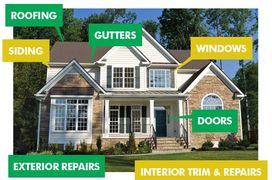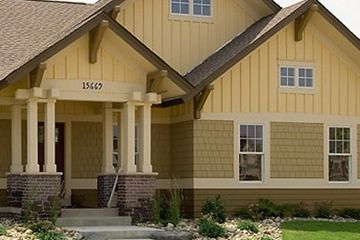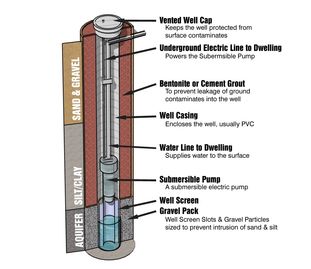Missouri OWTS Contractor Lic. #REY37531
Toll Free 1-844-534-6344
What We Can Do For You
Home Remodels

Our in-house design team has the experience and professionalism to design/build:
Kitchen & Bath Additions
Deck Additions
Garage Expansions
Home Office Additions
Kitchen & Bath Remodels
Window & Door Replacements
Siding & Roofing Replacement
Basement & Attic Conversions
Home Repairs

With over 25 years of Professional Home Building and Property Management Experience we've got you covered.
Plumbing - Electrical - Roofing - Carpentry - Siding - Flooring - Insulation - Windows & Doors - Interior & Exterior Painting - Exterior Staining - Decks - Foundations - Landscaping - Appliance Installs - Power Washing
Home and Property Inspections

We provide unbiased reporting on commercial, residential and environmental defects, meeting the highest standards in the industry. It is our duty to provide unbiased inspection findings to our customers. Making you aware of any major problems so you will not be left with costly headaches down the road is our top priority.
Mold Testing

When a home suffers a water damage event, a mold infestation can quickly arise and spread throughout a home in 48-72 hours. Because mold can produce allergens and irritants, you will want a professional that has training and experience to properly resolve the mold infestation. If you suspect that your home or business has a mold problem, we can inspect, assess and remediate your property.
Radon Testing

Radon is a radioactive gas that has been found in homes all over the United States. It comes from the natural breakdown of uranium in soil, rock, and water and gets into the air you breathe. Radon typically moves up through the ground to the air above and into your home through cracks and other holes in the foundation.
Free Radon Test Kit For Missouri Residents.
Frequently Asked Questions

Customers have questions, we have answers. We display the most frequently asked questions, so everybody benefits.
Estimated Project Pricing

Exterior Painting
1.70sf
Remember that every house is unique and will need to be looked at. Here are some ball park figures so you know what were assuming. We are going to assume that the house has an average amount of prep work, that we are doing 1 coat of paint, and that we are using Valspar/Behr paint – something around $25-$35 per gallon.
- One-Story house: $1800-$3000
- Two-Story house: $3000-$5000
- Three-Story house: $5000-$7500

Interior Painting
.90sf
There are several factors that go into determining the final cost of your project. In addition to average home size, costs can vary depending on:
- Type of paint: higher quality paints will cost more.
- Number of coats: some colors will require multiple coats of paint.
- Texture of the walls: highly textured walls may require special equipment, which can raise costs.
- Condition of the walls: we may have to patch holes, remove wallpaper, or put up drywall before painting, all of which can impact costs.
- Room being painted: some rooms cost more to paint than others, with factors like trim, windows, and furniture playing a role.
- Complexity of the work: murals, faux finishes, high ceilings, and other complex jobs can impact the cost.

Out of Room
140.00
When you want to add an additional room to your home, you typically have two options: build out or build up. This is a major construction project that involves creating an additional building structure and integrating it with the rest of the home. Average costs run anywhere from $80 to $200 per square foot.

Laminate Flooring Installation
$1.20sf
Cost Factors
There are several situations regarding a specific project or choices that homeowners can make about their laminate flooring that can increase or decrease the ultimate price of the project.
- Cost of the laminate material: Prices range from $1/sf to $5/sf on average
- Need for additional subflooring: may increase price by several hundred dollars
- Cost to remove and haul away existing flooring: may increase price by several hundred dollars or $1/sf - $2/sf

Tile Installation
6.40sq
Cost Factors
There are several situations regarding a specific project or choices that homeowners can make about their tile installation that can increase or decrease the ultimate price of the project.
- Cost of the tile material: Prices range from $1/sf to $5/sf on average
- Need for additional subflooring: may increase price by several hundred dollars
- Cost to remove and haul away existing flooring: may increase price by several hundred dollars or $1/sf - $2/sf
- Cost of new baseboard or trim: $50 - $250

Deck Prep/Staining
2.00sq
Cost Factors
There are several situations regarding a specific project or choices that homeowners can make about their decking that can increase or decrease the ultimate price of the project.
- Light sanding, stain and seal – This is a general annual treatment for a deck. It typically costs between $2 and $3.50 per square foot.
- Power washing, stain and seal – This is used for light maintenance, such as cleaning and sealing. It can cost between $1.50 and $2.50 per square foot.
- Rails and spindles – This is often an extra charge and needs to be looked at first.
Inspection Services

Certified OWTS (Septic) Inspections
- Missouri Licensed OWTS (Onsite Wastewater Treatment Systems) Installer and Inspector
- Missouri Licensed Well Inspector
- InterNational Association of Certified Home Inspectors
- Certified Professional Inspector® (CPI)
- Lagoon Inspection
- Sewage Contamination Testing

Certified Commercial & Residential Inspections
- Inter-National Association of Certified Home Inspectors
- Certified Professional Inspector® (CPI)
- Prelisting Inspection - Move In Certified
- New Construction Phase Inspections
- Mold Inspection
- Mold Testing
- Radon Testing
- Manufactured Home Foundation Inspection
- Infrared Thermography
- Wind & Hail Property Damage
- Log Home Inspections

Certified Well Inspections
- Well Water Testing
- Well Inspection
- Mechanical Inspection
Mold Testing & Abatement

Understanding Mold
Confusion and misunderstanding surround the topic of mold and mold remediation. Some restoration businesses even make claims to remove all mold from a building. This is a fallacy. Mold spores occur naturally almost everywhere, both indoors and outdoors. These microscopic spores float along in the air and can enter a home or business through windows and HVAC systems. Consider these facts:
- Mold is present almost everywhere, indoors and outdoors.
- Mold spores are microscopic and float along in the air and may enter your home through windows, doors, or AC/heating systems or even hitch a ride indoors on your clothing or a pet.
- Mold spores thrive on moisture. Mold spores can quickly grow into colonies when exposed to water. These colonies may produce allergens and irritants.
- Before mold remediation can begin, any sources of water or moisture must be addressed. Otherwise, the mold may return.
- Mold often produces a strong, musty odor and can lead you to possible mold problem areas.
- Even higher-than-normal indoor humidity can support mold growth. Keep indoor humidity below 45 percent.
What is "Black Mold"
We often hear about mold. And where there's water, there's mold. But have you ever heard the term "black mold" or "toxic mold?" It's a name commonly used for Stachybotrys chartarum. One of the most infamous toxic molds because it can grow in houses and is extremely dangerous to humans. Stachbotrys is known as a toxic mold because it produces toxins called mycotoxins. Mold can cause health effects and can also cause significant damage to you property. If your home or business encounter a water leak, don't hesitate to make that first call. We will inspect your property and look for signs of mold using technology designed to detect mold and hidden water resources.
If you have a mold problem in your home or business, your primary focus should be safety:
- Significant mold growth can occur in 48-72 hours.
- Mold may present a greater risk to children, the elderly, and anyone with respiratory problems.
- A strong, musty odor may indicate hidden mold behind drywall or under carpeting.
What to Do:
- Stay out of affected areas.
- Turn off the HVAC system and fans.
- Contact us for a free mold remediation analysis.
What Not to Do:
- Don’t touch or disturb the mold.
- Don’t blow air across any surfaces with visible or suspected mold growth.
- Don’t attempt to dry the area yourself.
- Don’t spray bleach or other disinfectants on the mold.
How Do I Tell if It's Black Mold?
Since many types of mold can cause reactions, you should contact us regardless of the color or type of mold. In many instances, multiple types of mold may exist in the same house or structure. If you suspect you have a mold problem, contact us immediately.
Radon Testing
7 Key Things Every Homeowner Should Know
1. What is radon?
Radon is a colorless, odorless radioactive gas that’s produced by decaying uranium. It’s present in nearly all soils, and very low levels of radon are found in the air we breathe every day.
2. Why is radon a problem?
The problem occurs when radon gas enters your home and gets trapped. Long-term exposure to high levels of radon can cause lung cancer. The Environmental Protection Agency estimates that lung cancer caused by radon exposure kills about 21,000 Americans every year.
3. How does radon get in your house?
The radon gas moves from the soil into a home. Although it can seep directly through pores in concrete, the worst entry points are gaps in walls and floors (see picture above). Any house, of any age, in any state can have elevated radon levels. It really depends on the way your specific house interacts with the surrounding soil. Your neighbor’s radon level may differ significantly from yours.
4. How do you test your home for radon?
Conduct the test in the lowest livable area of your house that is regularly used 8 to 10 hours per week.
5. What should you do if your house has high levels of radon?
If an initial short-term test registers 4 picoCuries per liter (pCi/L) or higher, the EPA recommends doing a second radon test. A long-term test will give you the most accurate information, but a short-term test is acceptable if you need the results quickly, such as for a real estate transaction, or your first levels registered 8 pCi/L or higher.
If a second test registers above 4 pCi/L, consider taking steps to reduce radon levels in your home
6.
How do you lower radon levels in your house?
You can start by trying these easy repairs to reduce radon levels. These efforts alone rarely reduce levels significantly, but if your level is only slightly elevated, these repairs might make the difference. They will also make other radon reduction methods more effective and cost efficient.
- Caulk foundation cracks, construction joints, and other openings with polyurethane caulk.
- If you have a sump pump, install an airtight cover on it (choose one that allows access to your sump).
- Cover soil in crawl spaces with polyurethane plastic sheeting (with a minimum thickness of 6 mil, available at home centers) tightly attached to the walls.
- You can also try sealing concrete, although the EPA has found concrete sealers to be a temporary solution at best.
7. What’s a radon mitigation system and how does it work?
It basically involves ventilating your home by using PVC piping to draw radon gas up from the soil and out of your house.
The most effective system is a vent pipe placed in the sump pit (if you have a sump pump) or a hole made under your concrete floor slab. A special in-line radon fan is placed in the attic or outside the house to draw air through the vent and radon from under the basement floor. The easiest method is to run the vent out the side of the house and up to the eaves. (You can also run the vent up through the house and out the roof, which is a lot more work and cost, but it looks better).

Copyright © 2018 C and C Inspection Services - All Rights Reserved.